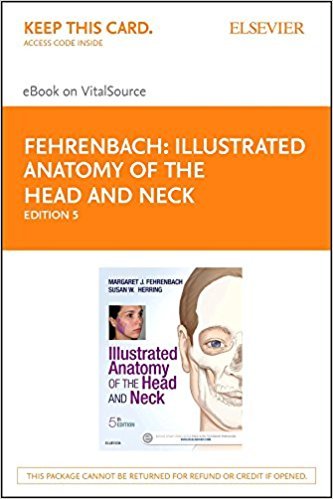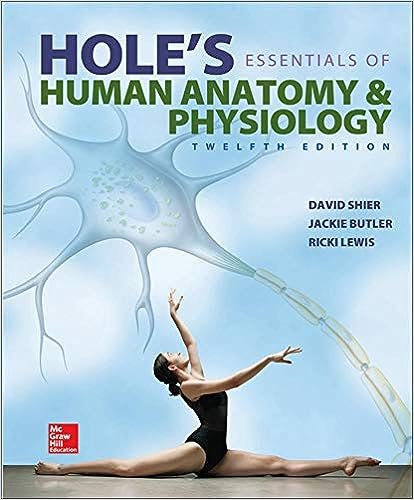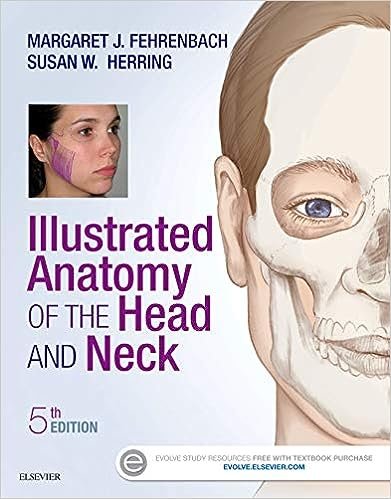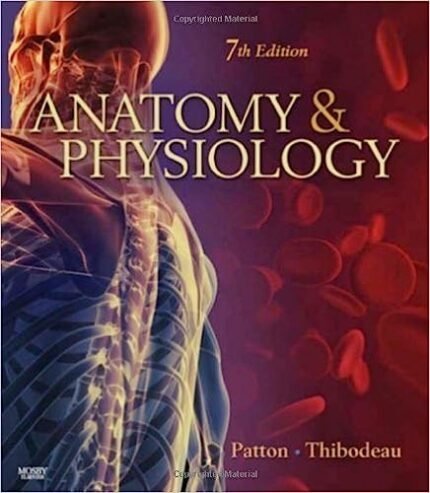Illustrated Anatomy of the Head and Neck 5th Edition by Margaret J. Fehrenbach- Test Bank
Chapter 12: Spread of Infection
Fehrenbach: Illustrated Anatomy of the Head and Neck, 5th Edition
MULTIPLE CHOICE
- Which of the following terms is BEST used to describe an infection with suppuration resulting from the entrapment of pathogens in a contained space?
| a. | Cellulitis |
| b. | Abscess |
| c. | Fistula |
| d. | Embolus |
ANS: B
| Feedback | |
| A | Cellulitis is a diffuse inflammation of soft tissue. |
| B | An abscess is an infection with suppuration resulting from the entrapment of pathogens in a contained space. |
| C | A fistula is a passageway in the skin, mucosa, or even bone that allows drainage of an abscess at the surface. |
| D | An embolus is foreign material or a thrombus traveling in the blood that can block the vessel. |
DIF: Recall REF: p. 290 OBJ: 2
TOP: CDA: General Chairside, I. A. Demonstrate understanding of basic oral and dental anatomy, physiology, and development | CDA: General Chairside, V. A. Oral Health Information | CDA: General Chairside, VI. B. 1. Recognize the signs and symptoms related to specific dental conditions/emergencies likely to occur in the office
MSC: NBDHE, Scientific Basis for Dental Hygiene Practice, 1.1 Anatomy | NBDHE, Scientific Basis for Dental Hygiene Practice, 5.0 Pathology | NBDHE, Provision of Clinical Dental Hygiene Services, 3.0 Planning and Managing Dental Hygiene Care | NBDHE, Provision of Clinical Dental Hygiene Services, 4.1 Etiology and pathogenesis of periodontal diseases
- Which of the following terms BEST describes the infectious process created by indigenous regional microorganisms because the body’s defenses are compromised?
| a. | Resident microbiota |
| b. | Suppuration |
| c. | Opportunistic infection |
| d. | Perforation |
ANS: C
| Feedback | |
| A | Resident microbiota is defined as indigenous regional microorganisms that usually do NOT cause infections. |
| B | Suppuration is pus containing pathogenic bacteria, white blood cells, tissue fluid, and debris. |
| C | An opportunistic infection is an infectious process created by resident microbiota when the body’s defenses are compromised. |
| D | A perforation is an abnormal hole in a hollow organ such as in the wall of a sinus. |
DIF: Recall REF: p. 293 OBJ: 2
TOP: CDA: General Chairside, I. A. Demonstrate understanding of basic oral and dental anatomy, physiology, and development | CDA: General Chairside, V. A. Oral Health Information | CDA: General Chairside, VI. B. 1. Recognize the signs and symptoms related to specific dental conditions/emergencies likely to occur in the office
MSC: NBDHE, Scientific Basis for Dental Hygiene Practice, 1.1 Anatomy | NBDHE, Scientific Basis for Dental Hygiene Practice, 5.0 Pathology | NBDHE, Provision of Clinical Dental Hygiene Services, 3.0 Planning and Managing Dental Hygiene Care
- Which of the following infections initially and DIRECTLY involves teeth and associated tissue?
| a. | Odontogenic infection |
| b. | Lymphadenitis |
| c. | Endophthalmitis |
| d. | Otitis media |
ANS: A
| Feedback | |
| A | An odontogenic infection is a dental infection involving the teeth and associated tissue. |
| B | Lymphadenitis is an infection of the lymph nodes. |
| C | Endophthalmitis is an infection within the ocular cavity usually involving the internal structures of the eye. |
| D | Otitis media is an infection of the middle ear, usually involving the eardrum. |
DIF: Recall REF: pp. 289-290 OBJ: 2
TOP: CDA: General Chairside, I. A. Demonstrate understanding of basic oral and dental anatomy, physiology, and development | CDA: General Chairside, V. A. Oral Health Information | CDA: General Chairside, VI. B. 1. Recognize the signs and symptoms related to specific dental conditions/emergencies likely to occur in the office
MSC: NBDHE, Scientific Basis for Dental Hygiene Practice, 1.1 Anatomy | NBDHE, Scientific Basis for Dental Hygiene Practice, 5.0 Pathology | NBDHE, Provision of Clinical Dental Hygiene Services, 3.0 Planning and Managing Dental Hygiene Care | NBDHE, Provision of Clinical Dental Hygiene Services, 4.1 Etiology and pathogenesis of periodontal diseases
- A dental professional SHOULD understand the infectious process that allows microorganisms to create disease. Certain nonresident microorganisms can invade and initiate an infection.
| a. | Both statements are true. |
| b. | Both statements are false. |
| c. | The first statement is true; the second is false. |
| d. | The first statement is false; the second is true. |
ANS: A
| Feedback | |
| A | Both the first and second statements are true. A dental professional SHOULD understand the infectious process that allows microorganisms to create disease. Certain nonresident microorganisms can invade and initiate an infection. |
| B | Both the first and second statements are true. A dental professional SHOULD understand the infectious process that allows microorganisms to create disease. Certain nonresident microorganisms can invade and initiate an infection. |
| C | The second statement is true. Certain nonresident microorganisms can invade and initiate an infection. |
| D | The first statement is true. A dental professional SHOULD understand the infectious process that allows microorganisms to create disease. |
DIF: Comprehension REF: p. 289 OBJ: 2
TOP: CDA: General Chairside, I. A. Demonstrate understanding of basic oral and dental anatomy, physiology, and development | CDA: General Chairside, I. B. Preliminary Physical Examination | CDA: General Chairside, V. A. Oral Health Information | CDA: General Chairside, VI. B. 1. Recognize the signs and symptoms related to specific dental conditions/emergencies likely to occur in the office
MSC: NBDHE, Scientific Basis for Dental Hygiene Practice, 1.1 Anatomy | NBDHE, Scientific Basis for Dental Hygiene Practice, 5.0 Pathology | NBDHE, Provision of Clinical Dental Hygiene Services, 1.0 Assessing Patient Characteristics | NBDHE, Provision of Clinical Dental Hygiene Services, 3.0 Planning and Managing Dental Hygiene Care | NBDHE, Provision of Clinical Dental Hygiene Services, 4.1 Etiology and pathogenesis of periodontal diseases
- Upon intraoral examination of a patient’s palate, you notice the presence of an abscess. Which teeth can be involved with the clinical presentation of this abscess?
| a. | Maxillary molars: buccal surface and buccal roots |
| b. | Maxillary lateral incisors: lingual surfaces and roots; maxillary premolars: lingual surfaces and roots; and maxillary molars: lingual surfaces and roots |
| c. | Maxillary anterior teeth: all surfaces and roots; maxillary posterior teeth: buccal surfaces and roots |
| d. | Maxillary molars: buccal surfaces and buccal roots; mandibular first and second molars: buccal surfaces and buccal roots |
ANS: B
| Feedback | |
| A | The maxillary molars, buccal surface and buccal roots, are involved when an abscess or fistula perforates into the maxillary sinuses. |
| B | The maxillary lateral incisors: lingual surfaces and roots; maxillary premolars: lingual surfaces and roots; and maxillary molars: lingual surfaces and roots are involved when an abscess or fistula is clinically present on the palate. |
| C | The maxillary anterior teeth (all surfaces and roots) and maxillary posterior teeth (buccal surfaces and roots) are involved when an abscess or fistula is clinically present in the maxillary vestibule. |
| D | The maxillary molars (buccal surfaces and buccal roots) and mandibular first and second molars (buccal surfaces and buccal roots) are involved when an abscess or fistula is clinically present on the buccal skin surface. |
DIF: Application REF: p. 292, Table 12-1 OBJ: 4
TOP: CDA: General Chairside, I. A. Demonstrate understanding of basic oral and dental anatomy, physiology, and development | CDA: General Chairside, II. C. Describe how to perform and/or assist with intraoral procedures | CDA: General Chairside, V. A. Oral Health Information | CDA: General Chairside, VI. B. 1. Recognize the signs and symptoms related to specific dental conditions/emergencies likely to occur in the office
MSC: NBDHE, Scientific Basis for Dental Hygiene Practice, 1.1 Anatomy | NBDHE, Scientific Basis for Dental Hygiene Practice, 5.0 Pathology | NBDHE, Provision of Clinical Dental Hygiene Services, 1.0 Assessing Patient Characteristics | NBDHE, Provision of Clinical Dental Hygiene Services, 3.0 Planning and Managing Dental Hygiene Care | NBDHE, Provision of Clinical Dental Hygiene Services, 4.1 Etiology and pathogenesis of periodontal diseases
- Which of the following disease states can DIRECTLY cause a periapical abscess?
| a. | Periodontal disease |
| b. | Chronic gingivitis |
| c. | Progressive caries |
| d. | Dentigerous cyst formation |
ANS: C
| Feedback | |
| A | Acute periodontal disease can cause a periodontal abscess to occur along with apical migration of the gingival tissue and alveolar bone. |
| B | Chronic gingivitis can cause the marginal and interdental gingival tissue to become enlarged and inflamed. |
| C | A periapical abscess can result from progressive caries. This occurs from an infection of the pulp causing the pulp to become necrotic due to invasion of microorganisms into the sterile pulp from the progressive caries. The infection will usually spread apically. |
| D | A dentigerous cyst is a developmental odontogenic cyst that forms around the crown of a developing impacted tooth. |
DIF: Comprehension REF: p. 290 OBJ: 4
TOP: CDA: General Chairside, I. A. Demonstrate understanding of basic oral and dental anatomy, physiology, and development | CDA: General Chairside, V. A. Oral Health Information | CDA: General Chairside, VI. B. 1. Recognize the signs and symptoms related to specific dental conditions/emergencies likely to occur in the office
MSC: NBDHE, Scientific Basis for Dental Hygiene Practice, 1.1 Anatomy | NBDHE, Scientific Basis for Dental Hygiene Practice, 5.0 Pathology | NBDHE, Provision of Clinical Dental Hygiene Services, 3.0 Planning and Managing Dental Hygiene Care | NBDHE, Provision of Clinical Dental Hygiene Services, 4.1 Etiology and pathogenesis of periodontal diseases
- Early detection of an abscess is imperative in order to avoid destruction of dental tissue. Early detection of an abscess is BEST accomplished with the use of dental radiographs.
| a. | Both statements are true. |
| b. | Both statements are false. |
| c. | The first statement is true; the second is false. |
| d. | The first statement is false; the second is true. |
ANS: C
| Feedback | |
| A | The second statement is false. Abscess formation may NOT be detectable on radiographs during the early stages. This is because the infection process may NOT have destroyed alveolar bone, thereby decreasing the density of the bone that can be seen radiographically as a radiolucent image. |
| B | The first statement is true. Early detection of abscess is imperative in order to avoid destruction of dental tissue. |
| C | The first statement is true. Early detection of abscess is imperative in order to avoid destruction of dental tissue. The second statement is false. Abscess formation may NOT be detectable on radiographs during the early stages. This is because the infection process may NOT have destroyed alveolar bone, thereby decreasing the density of the bone that can be seen radiographically as a radiolucent image. |
| D | The first statement is true. Early detection of abscess is imperative in order to avoid destruction of dental tissue. The second statement is false. Abscess formation may NOT be detectable on radiographs during the early stages. This is because the infection process may NOT have destroyed alveolar bone, thereby decreasing the density of the bone that can be seen on radiographs as a radiolucent image. |
DIF: Application REF: p. 290 OBJ: 5
TOP: CDA: General Chairside, I. A. Demonstrate understanding of basic oral and dental anatomy, physiology, and development | CDA: General Chairside, I. B. Preliminary Physical Examination | CDA: General Chairside, V. A. Oral Health Information | CDA: General Chairside, VI. B. 1. Recognize the signs and symptoms related to specific dental conditions/emergencies likely to occur in the office
MSC: NBDHE, Scientific Basis for Dental Hygiene Practice, 1.1 Anatomy | NBDHE, Scientific Basis for Dental Hygiene Practice, 5.0 Pathology | NBDHE, Provision of Clinical Dental Hygiene Services, 3.0 Planning and Managing Dental Hygiene Care | NBDHE, Provision of Clinical Dental Hygiene Services, 4.1 Etiology and pathogenesis of periodontal diseases
- Which of the following signs OR symptoms CANNOT be used to describe cellulitis of the face and neck?
| a. | Pain |
| b. | Tenderness |
| c. | Redness |
| d. | Systemic infection |
ANS: D
| Feedback | |
| A | Pain is often associated with infection and inflammation such as that which occurs with cellulitis, a diffuse inflammation of soft tissue spaces. |
| B | Tenderness is often associated with infection due to the swelling and pressure placed on surrounding nerves such as that which occurs with cellulitis, a diffuse inflammation of soft tissue spaces. |
| C | Redness or inflammation is often associated with infection such as that which occurs with cellulitis, a diffuse inflammation of soft tissue spaces. |
| D | Even though infection is associated with cellulitis, a diffuse inflammation of soft tissue spaces, the infection usually remains localized and is NOT systemic. |












Reviews
There are no reviews yet.